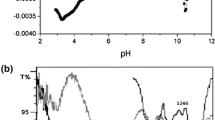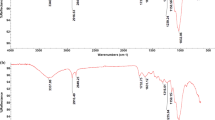Abstract
Grape stalks, a low-cost agro-industrial by-product, were used for the first time as a biosorbent for the removal of uranium from aquatic systems. Basic operating conditions (effect of pH, biosorbent dose, uranium initial concentration, and kinetics) were investigated, and the sorption mechanism was explored. The proposed biosorbent’s efficiency to sequester uranium from different profile aquatic systems was assessed, as well as the potential uranium recovery. Biosoprtion performance increased progressively from pH 1.5 to 4.5, and uranium uptake was a rapid process, where film diffusion was the determining step. Maximum uptake ranged from 90 to 115 mg U(VI) g−1 at 15–33 °C, respectively. None of the commonly used adsorption models (Langmuir, Freundlich, Dubinin-Radushkevich) was able to describe the experimental isotherms, whereas the linear model seems to provide the best fit. Kinetic and thermodynamic data implied that both physical and chemical sorption are involved in the process. Species calculation experiments showed that only positively charged and uncharged uranium species can be retained on the biomass. Quantitative uranium recovery was achieved by mild desorbing agents at concentrations as low as 0.1 M. Therefore, grape stalks seem to be a promising biosorbent due to their high sequestration capacity even under high salinity and acidity conditions, low cost, and easy regeneration.







Similar content being viewed by others
References
Ahmad, W. A., Jaapar, J., & Zahari, M. A. K. M. (2004). Removal of heavy metals from wastewater. In A. Pandey (Ed.), Concise encyclopedia of bioresource technology (pp. 152–157). NY: The Haworth Press Inc.
Al-Degs, Y. S., El-Barghouthi, M. I., Issa, A. A., Khraisheh, M. A., & Walker, G. M. (2006). Sorption of Zn(II), Pb(II), and Co(II) using natural sorbents: equilibrium and kinetic studies. Water Research, 40, 2645–2658.
Aldor, I., Fourest, E., & Volesky, B. (1995). Desorption of cadmium from algal biosorbent. Canadian Journal of Chemical Engineering, 73, 516–522.
Anagnostopoulos, V., Bekatorou, A., & Symeopoulos, B. (2011). Contribution to interpretation of metal uptake dependence upon the growth phase of microorganisms. The case of uranium (VI) uptake by common yeasts, cultivated at different temperatures, with or without aeration. Journal of Radioanalytical and Nuclear Chemistry, 287, 665–671.
Anayurt, R. A., Sari, A., & Tuzen, M. (2009). Equilibrium, thermodynamic and kinetic studies on biosorption of Pb(II) and Cd(II) from aqueous solution by macrofungus (Lactarius scrobiculatus) biomass. Chemical Engineering Journal, 151, 255–261.
Belgacem, A., Rebiai, R., Hadoun, H., Khemaissia, S., & Belmedani, M. (2014). The removal of uranium (VI) from aqueous solutions onto activated carbon developed from grinded used tire. Environmental Science and Pollution Research, 21, 684–694.
Bogolepov, A. A., Kobets, S. A., & Pshinko, G. N. (2009). Desorption of U(VI) from montmorillonite with aluminum and iron hydroxides deposited on its surface. Radiochemistry, 51, 301–307.
Bourikas, K., Kordulis, C., & Lycourghiotis, A. (2006). How metal (hydr)oxides are protonated in aqueous media: the (n + 1) rule and the role of the interfacial potential. Journal of Colloid and Interface Science, 296, 389–395.
Boyd, G. E., Adamson, A. W., & Myers, L. S., Jr. (1947). The exchange adsorption of ions from aqueous solutions by organic zeolites II. Kinetics. Journal of the American Chemical Society, 69, 2836–2848.
Cantrell, K.J., Serne, R.J., Last, G. V., (2002). Applicability of the linear sorption isotherm model to represent contaminant transport processes in site-wide performance assessments. PNNL-14576, U.S. Springfield, VA: Department of Energy.
Cecal, A., Humelnicu, D., Rudic, V., Cepoi, L., Ganju, D., & Cojocari, A. (2012). Uptake of uranyl ions from uranium ores and sludges by means of Spirulina platensis, Porphyridium cruentum and Nostok linckia alga. Bioresource Technology, 118, 19–23.
Cheung, W. H., Szeto, Y. S., & McKay, G. (2007). Intraparticle diffusion processes during acid dye adsorption onto chitosan. Bioresource Technology, 98, 2897–2904.
Deze, E. G., Papageorgiou, S. K., Favvas, E. P., & Katsaros, F. K. (2012). Porous alginate aerogel beads for effective and rapid heavy metal sorption from aqueous solutions: effect of porosity in Cu2+ and Cd2+ ion sorption. Chemical Engineering Journal, 209, 537–546.
Dupont, L., & Guillon, E. (2003). Removal of hexavalent chromium with a lignocellulosic substrate extracted from wheat bran. Environmental Science & Technology, 37, 4235–4241.
Ferraz, A. I., Tavares, T., & Teixeira, J. A. (2004). Cr(III) removal and recovery from Saccharomyces cerevisiae. Chemical Engineering Journal, 105, 11–20.
Fiol, N., Escudero, C., & Villaescusa, I. (2008). Chromium sorption and Cr(VI) reduction to Cr(III) by grape stalks and yohimbe bark. Bioresource Technology, 99, 5030–5036.
Foo, K. Y., & Hameed, B. H. (2010). Insights into the modeling of adsorption isotherm systems. Chemical Engineering Journal, 156, 2–10.
Ho, Y. S., & McKay, G. (2000). The kinetics of sorption of divalent metal ions onto sphagnum moss peat. Water Research, 34, 735–742.
Hritcu, D., Humelnicu, D., Dodi, G., & Popa, M. I. (2012). Magnetic chitosan composite particles: evaluation of thorium and uranyl ion adsorption from aqueous solutions. Carbohydrate Polymers, 87, 1185–1191.
Jakob, A. (1997). Modelling solute transport using the double porous medium approach. In I. Grenthe & I. Puigdomenech (Eds.), Modelling in aquatic chemistry. Paris: OECD.
Khani, M. (2011). Uranium biosorption by Padina sp. algae biomass: kinetics and thermodynamics. Environmental Science and Pollution Research, 18, 1593–1605.
Khani, M. H., Pahlavanzadeh, H., & Alizadeh, K. (2012). Biosorption of strontium from aqueous solution by fungus Aspergillus terreus. Environmental Science and Pollution Research, 19, 2408–2418.
Konstantinou, M., & Pashalidis, I. (2007). Adsorption of hexavalent uranium on biomass by-product. Journal of Radioanalytical and Nuclear Chemistry, 273, 549–552.
Kumar, D., & Gaur, J. P. (2011). Chemical reaction- and particle diffusion-based kinetic modeling of metal biosorption by a Phormidium sp.-dominated cyanobacterial mat. Bioresource Technology, 102, 633–640.
Kuyucak, N., & Volesky, B. (1989). Desorption of cobalt- laden algal biosorbent. Biotechnology and Bioengineering, 33, 815–822.
Landa, E. (2003). Mobilization of radionuclides from uranium mill tailings and related waste materials in anaerobic environments. Journal of Radioanalytical and Nuclear Chemistry, 255, 559–563.
Laus, R., Geremias, R., Vasconcelos, H. L., Laranjeira, M. C., & Favere, V. T. (2007). Reduction of acidity and removal of metal ions from coal mining effluents using chitosan microspheres. Journal of Hazardous Materials, 149, 471–474.
Liu, Y., & Xu, H. (2007). Equilibrium, thermodynamics and mechanisms of Ni2+ biosorption by aerobic granules. Biochemical Engineering Journal, 35, 174–182.
Martínez, M., Miralles, N., Hidalgo, S., Fiol, N., Villaescusa, I., & Poch, J. (2006). Removal of lead(II) and cadmium(II) from aqueous solutions using grape stalk waste. Journal of Hazardous Materials, 133, 203–211.
Moghaddam, M. R., Fatemi, S., & Keshtkar, A. (2013). Adsorption of lead (Pb2+) and uranium cations by brown algae; experimental and thermodynamic modeling. Chemical Engineering Journal, 231, 294–303.
Müller, K., Foerstendorf, H., Tsushima, S., Brendler, V., Bernhard, G., & Jaapar, J. (2009). Direct spectroscopic characterization of aqueous actinyl(VI) species: a comparative study of Np and U. The Journal of Physical Chemistry. A, 113, 6626–6632.
Naja, G., Mustin, C., Volesky, B., & Berthelin, J. (2005). A high resolution titrator: a new approach to studying binding sites of microbial biosorbents. Water Research, 39, 579–586.
Naja, G., Murphy, V., Volesky, B. (2009). Biosorption, metals. In: M. C. Flickinger (Hrsg.), Encyclopedia of Industrial Biotechnology Bioprocess, Bioseparation, and Cell Technology (pp. 4500). Wiley.
Özcan, A. S., & Özcan, A. (2004). Adsorption of acid dyes from aqueous solutions onto acid-activated bentonite. Journal of Colloid and Interface Science, 276, 39–46.
Pang, C., Liu, Y.-H., Cao, X.-H., Li, M., Huang, G.-L., Hua, R., Wang, C.-X., Liu, Y.-T., & An, X.-F. (2011). Biosorption of uranium(VI) from aqueous solution by dead fungal biomass of Penicillium citrinum. Chemical Engineering Journal, 170, 1–6.
Prodromou, M., & Pashalidis, I. (2013). Uranium adsorption by non-treated and chemically modified cactus fibres in aqueous solutions. Journal of Radioanalytical and Nuclear Chemistry, 298, 1587–1595.
Saǧ, Y., & Kutsal, T. (2000). Determination of the biosorption heats of heavy metal ions on Zoogloea ramigera and Rhizopus arrhizus. Biochemical Engineering Journal, 6, 145–151.
Sar, P., Kazy, S. K., Asthana, R. K., & Singh, S. P. (1999). Metal adsorption and desorption by lyophilized Pseudomonas aeruginosa. International Biodeterioration & Biodegradation, 44, 101–110.
Sarri, S., Misaelides, P., Papanikolaou, M., & Zamboulis, D. (2009). Uranium removal from acidic aqueous solutions by Saccharomyces cerevisiae, Debaryomyces hansenii, Kluyveromyces marxianus and Candida colliculosa. Journal of Radioanalytical and Nuclear Chemistry, 279, 709–711.
Sciban, M., Klasnja, M., & Skrbic, B. (2006). Modified softwood sawdust as adsorbent of heavy metal ions from water. Journal of Hazardous Materials, 136, 266–271.
Sciban, M., Radetic, B., Kevresan, Z., & Klasnja, M. (2007). Adsorption of heavy metals from electroplating wastewater by wood sawdust. Bioresource Technology, 98, 402–409.
Sprynskyy, M., Kowalkowski, T., Tutu, H., Cukrowska, E. M., & Buszewski, B. (2011). Adsorption performance of talc for uranium removal from aqueous solution. Chemical Engineering Journal, 171, 1185–1193.
Tsezos, M. (1989). Recovery of uranium from biological adsorbents. Desorption equilibrium. Biotechnology and Bioengineering, 26, 973–981.
Tsezos, M., Georgousis, Z., & Remoudaki, E. (1997). Mechanism of aluminium interference on uranium biosorption by Rhizopus arrhizus. Biotechnology and Bioengineering, 55, 16–27.
Ucun, H., Aksakal, O., & Yildiz, E. (2009). Copper(II) and zinc(II) biosorption on Pinus sylvestris L. Journal of Hazardous Materials, 161, 1040–1045.
Vilar, V. J. P., Botelho, C. M. S., & Boaventura, R. A. R. (2007). Copper desorption from Gelidium algal biomass. Water Research, 41, 1569–1579.
Villaescusa, I., Fiol, N., Martínez, M., Miralles, N., Poch, J., & Serarols, J. (2004). Removal of copper and nickel ions from aqueous solutions by grape stalks wastes. Water Research, 38, 992–1002.
Volesky, B. (2003). Sorption and biosorption. Montreal: SV Sorbex Inc.
Voudrias, E., Fytianos, K., & Bozani, E. (2002). Sorption–desorption isotherms of dyes from aqueous solutions and wastewaters with different sorbent materials. Global Nest Journal, 4, 75–83.
Wang, S., & Ariyanto, E. (2007). Competitive adsorption of malachite green and Pb ions on natural zeolite. Journal of Colloid and Interface Science, 314, 25–31.
Wang, X. A., Xia, L.-S., Zheng, W.-N., & Tan, K.-X. (2010). Adsorption behavior and mechanism of uranium (VI) on modified wheat straw. The Chinese Journal of Process Engineering, 10, 1084–1090.
Weber, W. J., & Morris, J. C. (1963). Kinetics of adsorption on carbon from solution. Journal of the Sanitary Engineering Division: The American Society of Civil Engineers, 89, 31–60.
Zheng, W.-N., Xia, L.-S., Wang, X., & Tan, K.-X. (2011). Adsorption behavior and mechanism of uranium by chaff. Atomic Energy Science and Technology, 45, 534–540.
Acknowledgments
This research has been co-financed by the European Union (European Regional Development Fund (ERDF)) and Greek national funds through the Operational Program “Regional Operational Programme” of the National Strategic Reference Framework (NSRF)—Research Funding Program: Support for research, technology and innovation actions in Region of Western Greece.
Conflict of Interest
The authors declare that they have no conflict of interest.
Author information
Authors and Affiliations
Corresponding author
Rights and permissions
About this article
Cite this article
Anagnostopoulos, V.A., Koutsoukos, P.G. & Symeopoulos, B.D. Removal of U(VI) from Aquatic Systems, Using Winery By-Products as Biosorbents: Equilibrium, Kinetic, and Speciation Studies. Water Air Soil Pollut 226, 107 (2015). https://doi.org/10.1007/s11270-015-2379-5
Received:
Accepted:
Published:
DOI: https://doi.org/10.1007/s11270-015-2379-5




